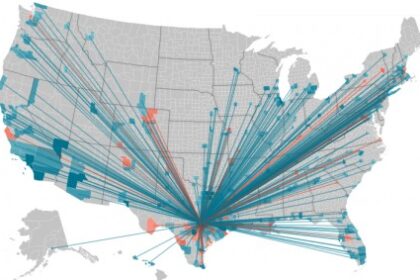
Talk radio this morning shared a Fast Company headline that Public schools are facing an existential Great Resignation of teachers. The National Education Association (NEA), released a new poll conducted to gauge the amount of stress on members today and it showed that 55% of teachers now say they’re going to leave the profession sooner than they’d planned. That percentage was only 37% last year. The latest employment figures indicate that even more Americans have resigned, adding fuel to the fires of what many of us have dubbed the Great Resignation.
According to the Bureau of Labor Statistics of the United States, 4 million Americans resigned in July 2021. Resignations spiked in April last year and have stayed unusually high for many months, with 10.9 million available positions at the end of July, setting a new record.
The Great Resignation is an informal term for the worldwide phenomenon of a large number of people quitting their employment in the wake of the COVID-19 outbreak. It has also been coined the Big Quit.
For years, I’ve been fascinated with the population shift, the migration, in the United States, from California and New York, into the central corridor of the county; well-known given the boom of attention on Texas as companies and venture capitalists follow the talent and economics of this region of the country. And while the Great Resignation is often addressed as a U.S. workforce shift, we’re seeing an awaking of people throughout the world, to the fact that they could live and work under better circumstances.
And that’s when Decypt’s news of YouTube’s Head of Gaming leaving to Join Polygon Studios really coalesced in my brain the fact that despite all of that has plagued, us as we start this decade of the 20s, what’s roaring forward is the fact that people aren’t resigning, they’re rethinking.
Two key trends have been revealed during the Great Resignation:
- Healthcare and tech industries have the highest resignations
Resignations in the healthcare industry grew by 3.6% compared to 2020, while those in the technology sector rose by 4.5%. We observed that resignation rates are significantly higher among workers who worked in sectors that had seen a dramatic increase in demand as a result of the pandemic, which likely led to an increase in workloads and burnout.
- Employees between 30-45 years old have high resignation rates
Those in their mid-career have an average increase in resignation rates of more than 20% between 2020 and 2021. It’s plausible that the change to remote work has made firms believe that employing somebody with less experience is riskier than normal since new hires will lack access to in-person training and supervision. This might have led to an increased demand for mid-career individuals, providing them more bargaining power when it comes to getting new roles.
Anthony Klotz, an organizational psychologist and professor at Texas A&M University, came up with the term The Great Resignation. And he mentioned to CNBC Make It that “It’s not just about getting another job, or leaving the workforce, it’s about taking control of your work and personal life and making a big decision – resigning – to accomplish that.” He also explains that this is actually a moment of empowerment for workers. Whether the consequence of employee discontent with present working circumstances, personal reassessments of professional and lifestyle choices, realizing the impact of the internet and how we can work from anywhere, or response to the pandemic’s changes and challenges, what’s evident is at least that people are changing.
What’s exciting is that while we can explore the negative causes, we can also explore the social changes end emerging capabilities that are rewarding people for making a change.
Article Highlights
The Promise of the Gig Economy
The Great Resignation has everyone socializing the circumstances… debating the cause, exploring how employers might emerge victoriously, and wrestling over how individuals will thrive after losing their employment.
The gig economy comprises a variety of employment opportunities. It has been linked with platforms such as Uber and Lyft in recent years, but it also refers to more general freelance or project-based employment – though these, too, are becoming more apparent on online hubs. In as much as our work is in Media, it’s evident through our community and economy, that the gig economy is far more than what people perceive in the recent spate of gig jobs – “Gig” iterates from the gigs that musicians land and the very notion of a gig economy draws from the form of work with which the media industry has long been familiar.
Focused on temporary, contract-based, or freelance work that often is an engagement, part-time, or a project, the gig economy is increasingly flourishing since communicating with clients or consumers, fans, and investors, is done online, enables work on our time and place.
The gig economy style of work helps employees, firms, and consumers by increasing the adaptability of employment to changing requirements and the need for flexible lifestyles.
The gig economy doesn’t come without consequences. Even if employees love the freedom from this work type, employers must also protect their workers from insecurity and overwork while people continue to struggle with benefits and consistency.
The Rise of the Creative Class
As gig work flourishes, we can appreciate how people are finding the time, flexibility, and balance to enjoy much of what is lost in a life of 9 to 5, in-office employment. People are rediscovering their creative roots (certainly in part too, thanks to being at home during the quarantines of 2020-2022) and it’s in this shift, that I think we’re not witnessing a Great Resignation merely as people get fed up with work; rather, the next Great Migration from how society used to work, to how people would prefer to live and work.
Richard Florida, a professor at the University of Toronto’s School of Cities and Rotman School of Management, used the term “creative class” to describe a new way of conceptualizing the engines of economic development. The creative class is those who prefer to live in places with cultural amenities and favorable environment surrounding including mixed populations.
Parag Agrawal, CEO of Twitter, this week, “Wherever you feel most productive and creative is where you will work and that includes WFH full-time forever.”
The class is comprised of workers, technologists, and cultural creators is a critical factor in the economic development of cities in America. Over 55 million employees, or more than 35% of the total, are classified as part of America’s creative class.
The creative class is one method of assessing talent or human capital in terms of employment or skill; the other is an educational achievement.
3) Wherever you feel most productive and creative is where you will work and that includes WFH full-time forever. 4) Distributed working will be challenging. We’ll need to be proactive, intentional, learn, and adapt. 5) Thank you to the team who has supported us every day.
— Parag Agrawal (@paraga) March 3, 2022
From the Internet to Everywhere
The Great Resignation has changed how people view work. Why stay in one place when you can work from anywhere? Why work 9 to 5 when you have an art class you can take in the morning or kids at soccer in the afternoon, and you certainly *can* work at any time your life makes available?
Businesses of all sizes are determining when and how their workers will return to work, but few companies are embracing the work-from-anywhere setup. Others still are holding to when everything might return to normal.
Media-oriented technology providers are exploring virtual methods to host conferences and product debuts, critical components of their attempts to foster developer and consumer loyalty and enthusiasm, but meaningful innovations in that they further our need and desire to connect and experience the world virtually and remotely.
As a result, companies are seeing the benefits in the transition to remote work, such as speeding up attempts by technology businesses to expand their workforces outside the West Coast hubs of Seattle and the San Francisco Bay Area, or New York, to not only Texas but all points throughout the world. The result is everyone migrating to where and how they’d prefer to live and work.
From Web 2.0 to Web3
There have been so many developments in the past years, but we have now entered a new phase on the internet.
From the second generation of the internet (Web 2.0) to the internet now emerging, Web3.
Web 2.0 refers to the internet as we know it today. It’s the shift from single web pages to an internet filled with interactivity, social networking, and user-generated content. Web 2.0 enables user-generated material to be seen instantly by millions of people worldwide and if you’re of the mind that “Social Media” refers only to Facebook or Twitter, you’re mistaken, the second generation of the internet is Social Media.
Web3 describes what the internet could be – decentralized, with greater user utility, and openness. It’s within Web3 that innovations such as blockchain, cryptocurrency, and NFTs, are what’s next, and it’s in Web3 that artificial intelligence, machine learning, and quantum computing will push humanity’s experience with the internet even further into experiences unknown.
With all these going on, and what will be, the Great Resignation is actually a great upgrade for all.
We are evolving. We are not resigning from jobs… we are only resigning from what the economy used to be and migrating what it is now and what it will be.
The Great Resignation is a Great Migration.
Web 1 was more or less a static experience as the early internet evolved into the World Wide Web full of websites built and pushed to us.
Web 2.0 with the emergence of blogs, social networks, and messaging, enabled everyone to participate and publish — the internet today is social media.
Web 3, what’s next, is decentralized, meaning fewer organizations own major pieces of it; or rather, everyone has more of a piece of it.
Creative Class Migration
The human spirit migrates from challenge to opportunity. We don’t just throw in the towel and give up, we move, we change and evolve. Whether the migration from our most distant of ancestors of the continent of Africa, or the migration from Europe to the New World, to that imagery shared above as early pioneers moved West, you know that we don’t resign, we move on.
Now, this is not to say that every employee will resign to start doing gig work. Rather, the Gig Economy, which has emerged post-COVID, seems to have coalesced with the Great Migration. This, in turn, creates a singularity of sorts.
Those that are interested in Gig work have much more substantial (and sustainable) options to do so. As these new economies develop, the Creative Class is able to leverage their independence from conventional employers. The Creative Class has more freedom and autonomy, as well as more opportunities to sustainably work in their field of choice. It seems that most of them have taken this opportunity.
This has been especially prevalent in the media industry, which I would argue is leading the Migration. Most media is reliant on gig work, and many more have entered the freelance media industry since COVID.
Of those participating in the Great Migration, we cannot ignore those choosing to leave their line of work to pursue a more creative career. Rather than view it as a decrease in the workforce, we should see this exodus as the growth of the Creative Class. It seems that the implications then are rather promising for the future.
Richard Florida today noted as well, the impact on our schools, “I’ve been thinking about remote work and schools … In the heat of the pandemic, many remote workers with families moved for space, outdoors, warm weather & looser restrictions. They discounted schools and school quality … The next remote work migration for families is likely to be for schools. Stay tuned …”



